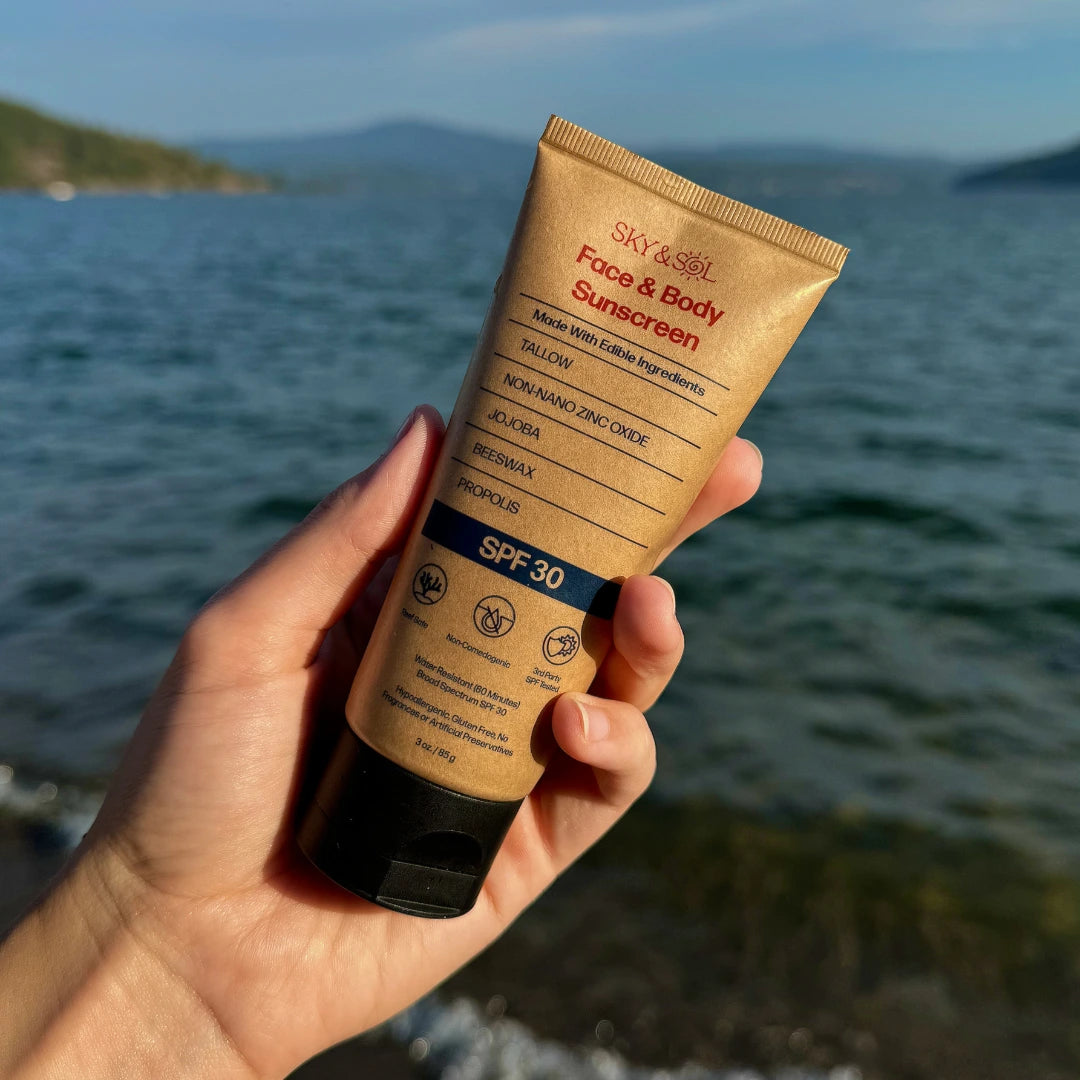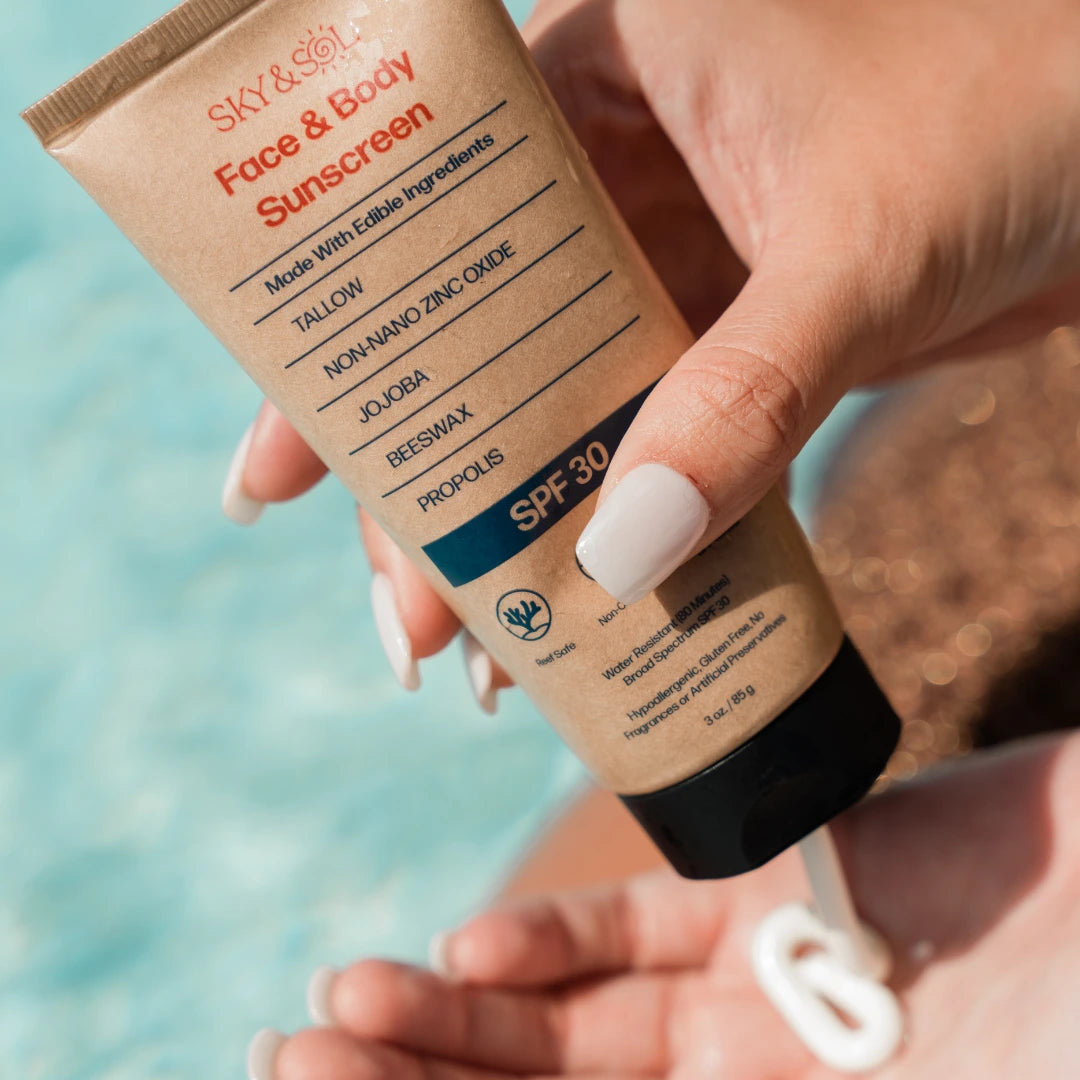Introduction
Sky and Sol is a brand that stands out in the skincare industry by focusing on both skin health and environmental well-being. What sets them apart is their dedication to creating products that are not only effective but also good for the planet. Their innovative sunscreens, available in SPF 50 and 30, are a perfect example of this unique approach to skincare.
Edible-Grade Ingredients for Superior Protection
Sky and Sol uses edible-grade ingredients such as tallow and non-nano zinc oxide in their sunscreens. This means that they prioritize using safe and natural components in their formulations. By doing so, they are able to provide excellent sun protection without relying on harmful chemicals that could potentially harm both individuals and the environment.
The Benefits of Chemical-Free Skincare with Sky and Sol
Choosing chemical-free products like those offered by Sky and Sol has several advantages. Firstly, it reduces the risk of exposing yourself to potentially harmful substances found in conventional skincare products. Secondly, it supports overall health by promoting the use of natural ingredients. Lastly, it aligns with a sustainable lifestyle by minimizing environmental impact.
The key takeaway is simple: Sky and Sol’s sunscreens offer effective sun protection while nourishing your skin with natural ingredients. For those seeking eco-friendly options, these sunscreens present an excellent choice, merging efficacy with sustainability seamlessly.
Review Sky and Sol if you value a harmonious blend of organic ingredients and environmental consciousness in your daily skincare routine.
The Innovative Formulation of Sky and Sol Sunscreens
Sky and Sol have taken a remarkable step in the skincare industry by using edible-grade ingredients in their sunscreen formulations. This approach not only ensures safety for skin application but also highlights the purity of their products. Imagine a sunscreen so safe, you could theoretically eat it—though we don’t recommend making it part of your diet!
Key Ingredients and Their Benefits
Tallow: The Moisturizing Powerhouse
One of the star ingredients, tallow, acts as a superb moisturizing agent. It’s rich in vitamins A, D, E, and K, which are known to deeply nourish the skin. Unlike many synthetic moisturizers, tallow doesn’t clog pores or lead to breakouts—a common concern for those with acne-prone or sensitive skin. Instead, it provides hydration that sinks deep into the skin layers, leaving it supple and soft. You can read more about the benefits of tallow in this in-depth review.
Non-Nano Zinc Oxide: Gentle Yet Effective Sun Protection
The addition of non-nano zinc oxide is another game-changer for Sky and Sol’s sunscreens. Zinc oxide is renowned for its ability to offer broad-spectrum protection against both UVA and UVB rays. By opting for non-nano particles, Sky and Sol ensure that the zinc stays on the surface of your skin rather than being absorbed into your body. This makes it an excellent choice for those with sensitive skin who need effective sun protection without irritation.
Why Choose Sky and Sol Sunscreens?
- Safety & Purity: Edible-grade ingredients underscore a commitment to health.
- Deep Hydration: Tallow hydrates without clogging pores.
- Sun Protection: Non-nano zinc oxide offers gentle yet robust UV defense.
Sky and Sol’s innovative use of these ingredients means you get all the benefits of sun protection while also treating your skin to nourishing goodness. This unique formulation positions their sunscreens as both a skincare essential and an eco-friendly choice that aligns with modern-day values.
Understanding SPF Ratings: SPF 50 vs SPF 30
When it comes to sun protection, SPF ratings are crucial. But what do these numbers really mean? SPF, or Sun Protection Factor, measures a sunscreen’s ability to prevent UVB rays from damaging the skin. If you usually burn after 10 minutes in the sun, an SPF 30 product allows you to stay in the sun 30 times longer without burning—about 5 hours.

Breaking Down the Numbers
- SPF 30: Blocks approximately 97% of UVB rays.
- SPF 50: Blocks about 98% of UVB rays.
The difference might seem minor but for those with sensitive skin or at high risk for skin cancer, every bit of extra protection counts.
UVA vs. UVB Rays
Both UVA and UVB rays contribute to the risk of skin cancer, but they affect your skin differently:
- UVA Rays: Penetrate deep into the skin, leading to aging and long-term damage.
- UVB Rays: Cause superficial damage like sunburns.
Choosing a sunscreen that provides broad-spectrum protection is essential as it shields against both types of rays, reducing the risk of premature aging and skin cancers.
Importance of Broad-Spectrum Protection
Regardless of whether you opt for SPF 30 or SPF 50, ensure the sunscreen offers broad-spectrum coverage. This ensures you’re protected against both UVA and UVB rays, giving your skin comprehensive defense against harmful solar exposure. Sky and Sol’s sunscreens exemplify this with their combination of non-nano zinc oxide and other natural ingredients, making them a sound choice for anyone prioritizing effective sun protection along with eco-friendly practices.
Understanding these elements helps in making informed decisions tailored to your specific needs and environment.
The Importance of Patch Testing Skincare Products Before Use
Trying out new skincare products can be exciting, but diving in headfirst isn’t always the best idea. Patch testing skincare products is a simple yet crucial step to ensure your skin will love the new additions as much as you do.
Why is it so important? This quick test helps identify any adverse reactions or allergies that might occur when introducing a new product. Skin sensitivities can range from mild irritation to severe reactions, and patch testing is your first line of defense in preventing these unwanted surprises.
Here’s a quick guide on how to properly conduct a patch test:
- Select a small area of skin, such as the inside of your wrist or behind your ear.
- Apply a small amount of the product and leave it on for 24-48 hours.
- Monitor the area for any signs of redness, itching, or swelling.
If no reaction occurs, it’s generally safe to use the product fully. Taking these precautions ensures your skincare routine remains effective and enjoyable.
How to Choose Effective Skincare Ingredients Based on Your Skin Type
Selecting the right skincare ingredients is like finding a perfect match—each skin type has its own needs and quirks. Here’s how you can choose ingredients tailored for your specific skin concerns:
1. Oily Skin
Opt for lightweight, non-comedogenic moisturizers. Ingredients like hyaluronic acid are brilliant as they hydrate without adding extra oil. Look for gel-based formulas that offer moisture minus the greasy feel.
2. Acne-Prone Skin
Be cautious of pore-clogging ingredients. Consider products with salicylic acid or niacinamide which helps in reducing inflammation and controlling oil production.
3. Dry Skin
Seek out richer emollients like squalane or ceramides. These help in repairing the skin barrier and retaining moisture.
4. Sensitive Skin
Go for soothing ingredients like aloe vera or chamomile. Avoid harsh additives and fragrances that might irritate your skin further.
Reviewing Sky and Sol’s offerings, their use of edible-grade tallow combined with non-nano zinc oxide caters to various skin types by providing hydration without clogging pores, making it an effective choice for those seeking eco-friendly yet effective skincare solutions.

Environmental Considerations in Skincare: The Case for Eco-Friendly Products Like Sky and Sol’s Offerings
Choosing environmentally friendly products in skincare isn’t just a trend; it’s a crucial step towards protecting our planet. Products like Sky and Sol’s sunscreens stand out because they embody sustainability across their entire production process. By opting for eco-friendly options, you’re supporting brands that prioritize both the health of your skin and the well-being of the environment.
Sustainable Ingredients for a Greener Future
Sky and Sol’s commitment to sustainability can be seen in their use of edible-grade ingredients such as tallow and non-nano zinc oxide. These components are not only safe for the skin but also less harmful to marine life, making it possible to enjoy sun protection without the guilt of contributing to coral reef damage.
Waste Reduction through Thoughtful Packaging
Beyond ingredient selection, eco-friendly brands often focus on reducing waste through minimalistic packaging designs and supporting sustainable sourcing practices. Here are some ways these practices make a difference:
- Reduced Carbon Footprint: Sourcing locally or responsibly lowers transportation emissions.
- Biodegradable Packaging: Using materials that break down naturally helps reduce landfill waste.
- Sustainable Harvesting: Ensures that natural resources are not depleted faster than they can regenerate.
By choosing products from companies like Sky and Sol, you’re investing in more than just skincare; you’re participating in a movement towards a healthier planet.
Conclusion
Choosing Sky & Sol’s innovative sunscreens means embracing a skin care routine that balances effectiveness with environmental mindfulness. These products offer a luxurious texture while utilizing edible-grade ingredients like tallow and non-nano zinc oxide, ensuring both safety and nourishment. By prioritizing chemical-free, eco-friendly skincare, you support sustainability and personal well-being. Whether you’re keen to review Sky & Sol or seeking to discover alternatives to beeswax, these sunscreens stand as a testament to responsible beauty choices that truly care for your skin and the planet.


